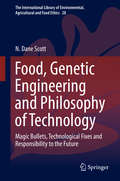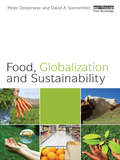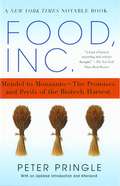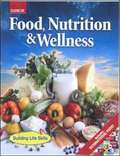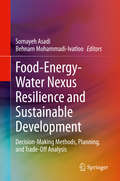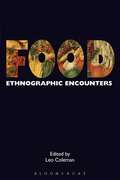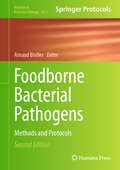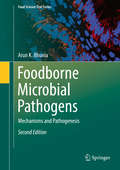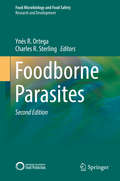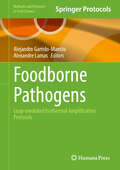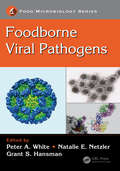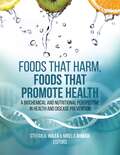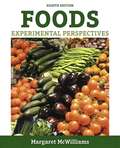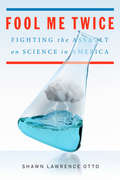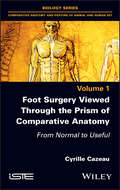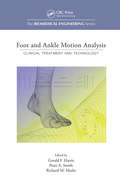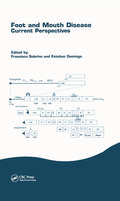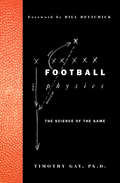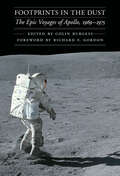- Table View
- List View
Food, Genes, and Culture: Eating Right for Your Origin
by Gary Paul NabhanVegan, low fat, low carb, slow carb: Every diet seems to promise a one-size-fits-all solution to health. But they ignore the diversity of human genes and how they interact with what we eat. In Food, Genes, and Culture, renowned ethnobotanist Gary Nabhan shows why the perfect diet for one person could be disastrous for another. If your ancestors were herders in Northern Europe, milk might well provide you with important nutrients, whereas if you're Native American, you have a higher likelihood of lactose intolerance. If your roots lie in the Greek islands, the acclaimed Mediterranean diet might save your heart; if not, all that olive oil could just give you stomach cramps. Nabhan traces food traditions around the world, from Bali to Mexico, uncovering the links between ancestry and individual responses to food. The implications go well beyond personal taste. Today's widespread mismatch between diet and genes is leading to serious health conditions, including a dramatic growth over the last 50 years in auto-immune and inflammatory diseases. Readers will not only learn why diabetes is running rampant among indigenous peoples and heart disease has risen among those of northern European descent, but may find the path to their own perfect diet.
Food, Genetic Engineering and Philosophy of Technology: Magic Bullets, Technological Fixes and Responsibility to the Future (The International Library of Environmental, Agricultural and Food Ethics #28)
by N. Dane ScottThis book describes specific, well-know controversies in the genetic modification debate and connects them to deeper philosophical issues in philosophy of technology. It contributes to the current, far-reaching deliberations about the future of food, agriculture and society. Controversies over so-called Genetically Modified Organisms (GMOs) regularly appear in the press. The biotechnology debate has settled into a long-term philosophical dispute. The discussion goes much deeper than the initial empirical questions about whether or not GM food and crops are safe for human consumption or pose environmental harms that dominated news reports. In fact, the implications of this debate extend beyond the sphere of food and agriculture to encompass the general role of science and technology in society. The GM controversy provides an occasion to explore important issues in philosophy of technology. Researchers, teachers and students interested in agricultural biotechnology, philosophy of technology and the future of food and agriculture will find this exploration timely and thought provoking.
Food, Globalization and Sustainability
by Peter Oosterveer David A. SonnenfeldFood is increasingly traded internationally, thereby transforming the organization of food production and consumption globally and influencing most food-related practices. This transition is generating unfamiliar challenges related to sustainability of food provision, the social impacts of international trade and global food governance. Distance in time and space between food producers and consumers is increasing and new concerns are arising. These include the environmental impact of food production and trade, animal welfare, the health and safety of food and the social and economic impact of international food trade. This book provides an overview of the principal conceptual frameworks that have been developed for understanding these changes. It shows how conventional regulation of food provision through sovereign national governments is becoming elusive, as the distinctions between domestic and international, and between public and private spheres, disappear. At the same time multi-national companies and supranational institutions put serious limits to governmental interventions. In this context, other social actors including food retailers and NGOs are shown to take up innovative roles in governing food provision, but their contribution to agro-food sustainability is under continuous scrutiny. The authors apply these themes in several detailed case studies, including organic, fair trade, local food and fish. On the basis of these cases, future developments are explored, with a focus on the respective roles of agricultural producers, retailers and consumers.
Food, Inc.
by Peter PringleFor most people, the global war over genetically modified foods is a distant and confusing one. The battles are conducted in the mystifying language of genetics. A handful of corporate "life science" giants, such as Monsanto, are pitted against a worldwide network of anticorporate ecowarriors like Greenpeace. And yet the possible benefits of biotech agriculture to our food supply are too vital to be left to either partisan. The companies claim to be leading a new agricultural revolution that will save the world with crops modified to survive frost, drought, pests, and plague. The greens warn that "playing God" with plant genes is dangerous. It could create new allergies, upset ecosystems, destroy biodiversity, and produce uncontrollable mutations. Worst of all, the antibiotech forces say, a single food conglomerate could end up telling us what to eat. In Food, Inc., acclaimed journalist Peter Pringle shows how both sides in this overheated conflict have made false promises, engaged in propaganda science, and indulged in fear-mongering. In this urgent dispatch, he suggests that a fertile partnership between consumers, corporations, scientists, and farmers could still allow the biotech harvest to reach its full potential in helping to overcome the problem of world hunger, providing nutritious food and keeping the environment healthy.
Food, Nutrition & Wellness
by Roberta Larson DuyffMotivate your students to develop healthy eating and fitness habits withGlencoeFood, Nutrition, & Wellness! Authored by a prominent member of theAmerican Dietetic Association Based on the latest in nutrition science and research Writtten in accessible style with many activities to provide applications, practice, and involvement Offers recipes for both All-American favorites and International dishes Focuses on nutrition basics, food prep, and kitchen basics (including a strong focus on safety and sanitation) Illustrates food prep process step-by-step inhow-to features Supports project-based learning with unit-long, hands-on applications Provides point-of-use academic integration (math, science, and English language arts) to help teachers meet Perkins mandates
Food, Senses and the City (Routledge Studies in Food, Society and the Environment)
by Ferne Edwards Roos Gerritsen Grit WesserThis work explores diverse cultural understandings of food practices in cities through the senses, drawing on case studies in the Americas, Asia, Australia, and Europe. The volume includes the senses within the popular field of urban food studies to explore new understandings of how people live in cities and how we can understand cities through food. It reveals how the senses can provide unique insight into how the city and its dwellers are being reshaped and understood. Recognising cities as diverse and dynamic places, the book provides a wide range of case studies from food production to preparation and mediatisation through to consumption. These relationships are interrogated through themes of belonging and homemaking to discuss how food, memory, and materiality connect and disrupt past, present, and future imaginaries. As cities become larger, busier, and more crowded, this volume contributes to actual and potential ways that the senses can generate new understandings of how people live together in cities. This book will be of great interest to students and scholars of critical food studies, urban studies, and socio-cultural anthropology.
Food-Borne Pathogens
by Catherine AdleyA collection of readily reproducible classic and emerging molecular methods for the laboratory isolation and identification of the pathogens, viruses, and parasites that cause food-borne disease. Among the pathogens covered are specific bacteria, including Salmonella spp, Campylobacter spp., Listeria spp., and Bacillus spp.; viruses, including noroviruses and enteroviruses; and parasites, including Cryptosporidium and seafood nematode worms. The protocols follow the successful Methods in BiotechnologyTM series format, each offering step-by-step laboratory instructions, an introduction outlining the principles behind the technique, lists of the necessary equipment and reagents, and tips on troubleshooting and avoiding known pitfalls.
Food-Energy-Water Nexus Resilience and Sustainable Development: Decision-Making Methods, Planning, and Trade-Off Analysis
by Behnam Mohammadi-Ivatloo Somayeh AsadiThis book presents readers with an integrated modeling approach for analyzing and understanding the interconnection of water, energy, and food resources and discusses the relationship between resilience and sustainability of the food- energy –water (FEW) system. Authors provide novel frameworks, models, and algorithms designed to balance the theoretical and applicative aspects of each chapter. The book covers an integrated modeling approach for FEW systems along with developed methods, codes, and planning tools for designing interdependent energy, water and food systems. In-depth chapters discuss the impact of renewable energy resources in FEW systems, sustainable design and operation, net zero energy buildings, and challenges and opportunities of the FEW nexus in the sustainable development of different countries. This book is useful for graduate students, researchers, and engineers seeking to understand how sustainable FEW systems contribute to the resilience of these systems and help policy and design makers allocate and prioritize resources in an integrated manner across the food, energy, and water sectors.
Food: Ethnographic Encounters (Encounters: Experience and Anthropological Knowledge Series #3)
by Leo ColemanFood preparation, consumption, and exchange are eminently social practices, and experiencing another cuisine often provides our first encounter with a different culture. This volume presents fascinating essays about cooking, eating, and sharing food, by anthropologists working in many parts of the world, exploring what they learned by eating with others. <p><p> These are accounts of specific experiences - of cooking in Mombasa, shopping for organic produce in Vienna, eating vegetarian in Vietnam, raising and selling chickens in Hong Kong, and of refugees subsisting on food aid. With a special focus on the experience and challenge of ethnographic fieldwork, the essays cover a wide range of topics in food studies and anthropology, including food safety and food security, cultural diversity and globalization, colonial histories and contemporary identities, and changing ecological, social, and political relations across cultures. <p><p> Food: Ethnographic Encounters offers readers a broad view of the vibrancy of local and global food cultures, and provides an accessible introduction to both food studies and contemporary ethnography.
Foodborne Bacterial Pathogens: Methods and Protocols (Methods in Molecular Biology #1918)
by Arnaud BridierThis volume presents a compilation of various representative techniques and approaches currently used to study bacterial foodborne pathogens. Chapters guide the reader through bacterial pathogen detection and quantification in food, molecular, phenotypic, metabolic characterization of food pathogens, and ecology of foodborne bacterial pathogens. Written in the highly successful Methods in Molecular Biology series format, chapters include introductions to their respective topics, lists of the necessary materials and reagents, step-by-step, readily reproducible laboratory protocols, and tips on troubleshooting and avoiding known pitfalls.Authoritative and cutting-edge, Foodborne Bacterial Pathogens : Methods and Protocols aims to server as a guide both for researchers, students, and those in the food industry who want to have an overview of current approaches and protocols used to study bacterial foodborne pathogens.
Foodborne Bacterial Pathogens: Methods and Protocols (Methods in Molecular Biology #2852)
by Arnaud BridierThis updated volume presents a compilation of various representative techniques and approaches currently used to study bacterial foodborne pathogens. Chapters guide the reader through bacterial pathogen detection and quantification in food, molecular, phenotypic, metabolic characterization of food pathogens, and ecology of foodborne bacterial pathogens. Written in the highly successful Methods in Molecular Biology series format, chapters include introductions to their respective topics, lists of the necessary materials and reagents, step-by-step, readily reproducible laboratory protocols, and key tips on troubleshooting and avoiding known pitfalls. Authoritative and cutting-edge, Foodborne Bacterial Pathogens: Methods and Protocols, Second Edition aims to ensure successful results in the further study of this vital field.
Foodborne Microbial Pathogens: Mechanisms And Pathogenesis (Food Science Text Ser.)
by Arun K. BhuniaThis book primarily covers the general description of foodborne pathogens and their mechanisms of pathogenesis, control and prevention, and detection strategies, with easy-to-comprehend illustrations. The book is an essential resource for food microbiology graduate or undergraduate students, microbiology professionals, and academicians involved in food microbiology, food safety, and food defense-related research or teaching. This new edition covers the significant progress that has been made since 2008 in understanding the pathogenic mechanism of some common foodborne pathogens, and the host-pathogen interaction. Foodborne and food-associated zoonotic pathogens, responsible for high rates of mortality and morbidity, are discussed in detail. Chapters on foodborne viruses, parasites, molds and mycotoxins, and fish and shellfish are expanded. Additionally, chapters on opportunistic and emerging foodborne pathogens including Nipah virus, Ebola virus, Aeromonas hydrophila, Brucella abortus, Clostridium difficile, Cronobacter sakazakii, and Plesiomonas shigelloides have been added. The second edition contains more line drawings, color photographs, and hand-drawn illustrations.
Foodborne Parasites
by Ynés R. Ortega Charles R. SterlingThe globalization and commercialization of the food system has unintentionally led to the introduction of new foodborne parasites in countries worldwide. Fortunately, advances in detection and control are providing the basis for a better understanding of the biology and control of parasitic infections, and this in turn will likely contribute to the reduction and hopefully elimination of parasitic foodborne outbreaks. Building on the first edition, this completely revised second edition of Foodborne Parasites covers the parasites most associated with foodborne transmission and therefore of greatest global public health relevance. The volume examines protozoa and their subgroups: the amoeba, coccidia, flagellates and ciliates. Chapters also address Trypanosoma cruzi, recently recognized as an emerging foodborne protozoan. The helminth section is expanded to cover teniasis, cysticercosis, hydatidosis, and the trematodes and nematodes including Angiostrongylus, which is present worldwide. Finally, the editors examine the burden and risk assessment determinations that have provided a scientific framework for developing policies for the control of foodborne parasites.
Foodborne Pathogens: Loop-mediated Isothermal Amplification Protocols (Methods and Protocols in Food Science)
by Alejandro Garrido-Maestu Alexandre LamasThis volume details reliable protocols for the successful implementation of LAMP assays for the detection of the most relevant foodborne pathogens and antibiotic resistance microorganisms. Chapters guides the reader through different types of detection strategies, from the most classical ones to the most recent ones focused on color change or even the implementation of nanomaterials are covered, along with specific applications in point-of care devices and even primer design. Written in the format of the Methods and Protocols in Food Science series, chapters list necessary materials and methods for readily reproducible protocols. Authoritative and cutting-edge, Food Bourne Pathogen: Loop-mediated Isothermal Amplification Protocols aims to be comprehensive guide for researchers in the field. Authoritative andcutting-edge, Loop-mediated isothermal amplification: foodborne pathogendetection and characterization aims to provide comprehensive and updated state-of-art methodologies for food analysis.
Foodborne Viral Pathogens (Food Microbiology)
by Peter White Natalie Netzler Grant HansmanViral transmission through contaminated food and water claims hundreds of thousands of lives every year, particularly affecting children in developing nations. Foodborne viral pathogens are associated with gastroenteritis and hepatitis, causing widespread epidemics that affect all populations and demographics worldwide. Foodborne Viral Pathogens comprehensively covers the predominant etiological viral agents of foodborne disease, including norovirus, hepatitis A virus, hepatitis E virus, astrovirus, sapovirus and rotavirus, and several emerging viruses and prions. By improving food safety awareness and viral detection, and through promotion of global food safety standards, our ability to cope with and control foodborne disease will be enhanced. Foodborne Viral Pathogens includes a detailed review of the molecular biology, potential vaccines, and available antiviral treatments of all major foodborne viral pathogens and prions. Written by specialists and leading virologists, this book features techniques used for typing, viral detection, strategies for control, and viral risk assessments. This book is intended as a detailed handbook for food microbiology and medical applications and will be a useful guide for anyone with an interest in foodborne disease.
Foods That Harm, Foods That Promote Health: A Biochemical and Nutritional Perspective in Health and Disease Prevention
by Stefan A. Hulea AhmadiThis book looks at fresh (fruits and vegetables) and processed foods from a biochemical and nutritional perspective, as well as the relationship between their content in micronutrients and phytochemicals and the major killer diseases such as cardiovascula
Foods: Experimental Perspectives
by Margaret McWilliamsPreparing aspiring professionals with clearly written, in-depth scientific coverage of food and its safe preparation. Never before has food received so much attention. Today's news shines a spotlight on food, food science, and nutrition ― beckoning today’s readers to an exciting career in this essential industry. Foods: Experimental Perspectives, Eighth Edition blends the underlying science with discussion of GMOs, sustainability, healthy and trendy food choices, and other current consumer issues. Its clear presentation of the science guides readers through complex concepts that influence practices in food preparation and product development. The study of foods begins with an in-depth presentation of carbohydrates and food sources, followed by a careful look at lipids, and ultimately proteins and their principal sources. Aspects of the food supply, including safety, preservation, and additives are then examined. Discussion of the research process and evaluation techniques used in food research and product development close the text. Professional vocabulary is developed through margin definitions and a substantial glossary, while other learning aids ― chapter objectives, summaries, study questions, "Food for Thought" boxes, and photos ― support the reader's journey through the exciting look at food, food science, and food safety.
Fool Me Twice: Fighting the Assault on Science in America
by Shawn Lawrence Otto"Whenever the people are well informed," Thomas Jefferson wrote, "they can be trusted with their own government."But what happens in a world dominated by complex science? Are the people still well-enough informed to be trusted with their own government? And with less than 2 percent of Congress with any professional background in science, how can our government be trusted to lead us in the right direction?Will the media save us? Don't count on it. In early 2008, of the 2,975 questions asked the candidates for president just six mentioned the words "global warming" or "climate change," the greatest policy challenge facing America. To put that in perspective, three questions mentioned UFOs.Today the world's major unsolved challenges all revolve around science. By the 2012 election cycle, at a time when science is influencing every aspect of modern life, antiscience views from climate-change denial to creationism to vaccine refusal have become mainstream.Faced with the daunting challenges of an environment under siege, an exploding population, a falling economy and an education system slipping behind, our elected leaders are hard at work ... passing resolutions that say climate change is not real and astrology can control the weather.Shawn Lawrence Otto has written a behind-the-scenes look at how the government, our politics, and the media prevent us from finding the real solutions we need. Fool Me Twice is the clever, outraged, and frightening account of America's relationship with science—a relationship that is on the rocks at the very time we need it most.
Foot Surgery Viewed Through the Prism of Comparative Anatomy: From Normal to Useful
by Cyrille CazeauComparative anatomy helps to define among surgical procedures, those that are able to restore early walking function using really useful structures, without necessarily respecting the normal anatomy. This book proposes an original vision based on the following ideas : • The cure is complete only if it occurs quickly, which is vital for vulnerable patients. • The surgical goal isn't the anatomical restitution ad integrum, but to resore the fonction, that of the permanent terrestrial human bipedalism. To identify it, put it back into its evolutionary context and compare it to the anatomo-functional models of our closest relatives, the great apes. • Achieving this dual objective through new surgical techniques (percutaneous and minimally invaseve), associated with biomechanical data for immediate and total support.
Foot and Ankle Motion Analysis: Clinical Treatment and Technology
by Gerald F. Harris Peter A. SmithHuman motion analysis or gait analysis is used throughout the country and the world in clinics for pre-surgical planning and postsurgical follow-up. Only recently have technological advances truly begun to meet medical needs by supplying more accurate analytical data from which to make educated assessments of dynamic foot and ankle pathology. A com
Foot and Mouth Disease: Current Perspectives
by Esteban Domingo Francisco SobrinoThe shock following the recent outbreak of foot-and-mouth disease (FMD) in the UK dispelled the notion that this disease was permanently under control and could be forgotten. FMD proved to be an endemic disease in many countries and continues to pose a major threat to animal health worldwide. The development of more effective and socially acceptabl
Football Physics: The Science of the Game
by Timothy GayYou'll never view a football game in quite the same way again--the ultimate guide for the millions of impassioned fans who have turned football into America's most watched sportWhat effect does altitude have on the flight of a kicked ball? How do Newton's laws of motion apply to blocking and tackling? What does the science of physics reveal to us about the optimal chase strategies for defensive backs? In this illuminating , enormously entertaining book, a physics professor with a rare gift for making science easy to understand-and fun-for the lay reader reveals the unseen natural laws that govern football. And in so doing, Dr. Timothy Gay broadens and deepens our appreciation for the strategic nuances of this deceptively simple game.The success of such well received titles as The Physics of Baseball and The Physics of Golf has already demonstrated fans' fascination with the science underlying their favorite sport. But never before have basic physical principles been explained so clearly for sports fans with no scientific background. Readers will relive the game's enthralling moments and legendary feats-Franco Harris's Immaculate Reception, Joe Montana's scrambling pass for The Catch, Dick Butkus's bone-crunching, game-saving tackles, and many more-as they gain new insight into the dynamics of blocking and tackling, open field running, kicking, passing, the line of scrimmage, and the role played by equipment, turf, and the decibels of sound in stadiums. Illustrated with classic black-and-white NFL action photos along with engaging popular-science diagrams, the book is an outgrowth of Dr. Gay's playful, brilliant lectures on the physics of football that have been adapted by the NFL for videos shown on the TV show Blast! which airs in 190 foreign countries.
Footprints On The Moon
by Alexandra SiyOn July 20, 1969, at 3:16 p.m., Commander Neil Armstrong brought the lunar module, Eagle , to a safe landing on the Moon. Millions of television viewers on Earth watched breathlessly as he then became the first man to set foot on the Moon. This amazing achievement was years, even centuries, in the making. The Moon and the heavens have intrigued mankind since ancient times. <P><P>FOOTPRINTS ON THE MOON chronicles the spirit and determination of visionaries from Galileo to John F. Kennedy, whose dream of reaching the Moon was finally and superbly realized through the efforts of the Apollo missions. <P><P> With a compelling and thoroughly researched text, the great vision of the scientists, engineers, and astronauts who struggled to make the dream a reality is brought into sharp focus. The book brings to light great triumphs and tragedies. Readers will learn about the years of determination, experimentation, and risk that gave rise to many space explorations, including 17 Apollo missions. Today the Moon is less of a mystery than in ancient times, but it is still a wonder. <P><P> Breathtaking photographs--many from NASA--portray the indescribable beauty of outer space, the Moon, and the wonder of mankind's inspiring vision.
Footprints in the Dust: The Epic Voyages of Apollo, 1969-1975 (Outward Odyssey: A People's History of Spaceflight)
by Colin BurgessFollowing the fortieth anniversary of Apollo 11, as NASA prepares to return astronauts to the moon, Footprints in the Dust offers a thorough, engrossing, and multifaceted account of the Apollo missions. The flight of Apollo 11 was a triumph of human endeavor, persistence, and technology, one of the greatest achievements in human history. This book begins with the mission that sent Neil Armstrong and Edwin &“Buzz&” Aldrin to the moon, then follows American spaceflight through the harrowing rescue of Apollo 13 before moving on to the successful joint Apollo-Soyuz mission in 1975. Drawing on extensive research and interviews with key figures in the space program, the authors convey the human drama and chart the technological marvels that went into the Apollo missions. They also put the accomplishments of American spaceflight into historical context, examining the competitive space race with the Soviet Union, the roles of politics and personality in launching the mission, and the consequences, practical and profound, of this giant leap for mankind.
Footprints of Schizophrenia
by Steven Lesk M.D.Of all the mental illnesses, schizophrenia eludes us the most. No matter the strides scientists have made in neurological research nor doctors have made in psychiatric treatment, schizophrenia remains misunderstood, almost complacently mythologized. Without a reason for the illness, patients feel even more alienated than they already do, families are left hopeless, and doctors struggle to provide accurate care. Steven Lesk, though, after a medical career dedicated to those affected by schizophrenia and a determination to find the answer to its existence, presents a groundbreaking theory that will forever change the lives of the mentally ill. In Footprints of Schizophrenia: The Evolutionary Roots of Madness, Lesk threads evolutionary evidence with neurological evidence, turning the mysteries of our minds into a tapestry of logic. With his breakthrough theory and this unprecedented book, Lesk will invite necessary cultural dialogue about this stigmatized illness, provoke new psychiatric and pharmacological research, and provide unequivocal comfort to those afflicted and affected by schizophrenia.Lesk&’s &“primitive organization theory&” is based in human evolution, from Neanderthals to Homo sapiens, and the specific changes to our brains after the emergence of language. We have existed in human-like form for six million years, but we&’ve only had language for 50,000; within the vast span of evolutionary time, that&’s hardly any time at all. Lesk elucidates us to the hormones affected by language, especially dopamine, and with brilliant clarity, connects human evolution, our brain affected by language, and those with schizophrenia whose dopamine doesn&’t flow in our new, adaptive way. In other words, the twenty million people who have schizophrenia in the world don&’t suppress dopamine in the way evolution has trained us, so their brains don&’t process language well and function as if they&’re in a hallucinatory, delusional dream state. Not only will Lesk&’s theory focus treatment efforts for schizophrenia, but it will also affect that of other dopamine-related mental illnesses like Alzheimer&’s, Parkinson&’s, Huntington&’s chorea, Tourette&’s, ADD, and more. Publishing Lesk&’s work will usher in a new era of psychiatric understanding, one that the field and the public desperately needs.

